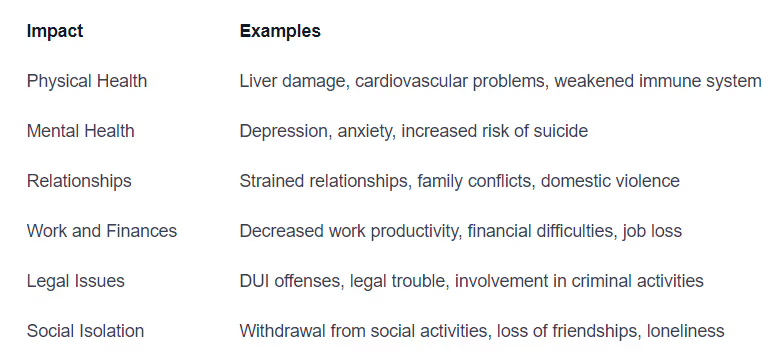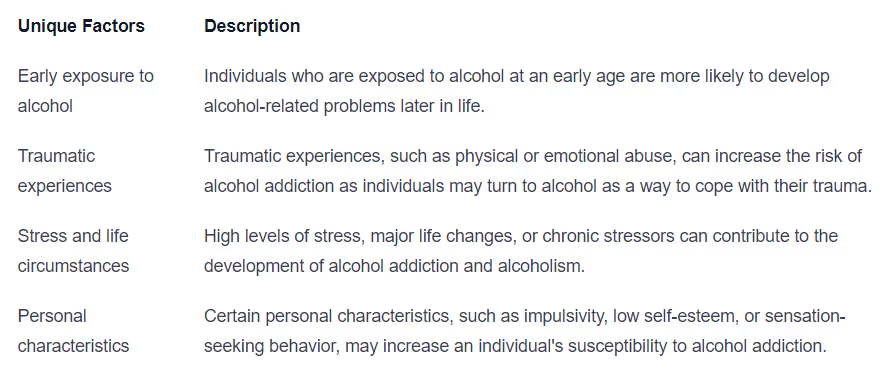Causes of Alcohol Addiction and Alcoholism

Understanding Alcohol Addiction and Alcoholism
Alcohol addiction and alcoholism are serious conditions that can have a significant impact on an individual's physical, mental, and social well-being. It is important to understand the differences between alcohol addiction and alcoholism, as well as the overall impact they can have on individuals and society.
Differentiating Alcohol Addiction and Alcoholism
While the terms "alcohol addiction" and "alcoholism" are often used interchangeably, there are subtle distinctions between the two:
- Alcohol Addiction: Alcohol addiction refers to a pattern of compulsive alcohol use, where an individual develops a physical and psychological dependence on alcohol. They may experience cravings, loss of control, and withdrawal symptoms when attempting to cut down or stop drinking. Alcohol addiction can manifest in various ways, but it does not necessarily indicate that the person has reached the stage of alcoholism.
- Alcoholism: Alcoholism, also known as alcohol use disorder (AUD), is a more severe form of alcohol addiction. It is characterized by a chronic and compulsive pattern of alcohol use, despite negative consequences. Individuals with alcoholism often exhibit a loss of control over their drinking, prioritize alcohol over other responsibilities, and experience physical and psychological withdrawal symptoms when they try to quit or reduce their intake.
The Impact of Alcohol Addiction and Alcoholism
Alcohol addiction and alcoholism can have far-reaching consequences, affecting not only the individuals themselves but also their families, communities, and society as a whole. Some of the common impacts include:

It is important to recognize the seriousness of alcohol addiction and alcoholism, as well as the potential negative consequences that can arise from these conditions. Seeking help and support, whether through professional treatment, support groups, or counseling services, is crucial for individuals struggling with alcohol addiction and alcoholism. By understanding the causes and effects of these conditions, we can work towards prevention, early intervention, and effective treatment approaches to address this widespread issue.
Genetic Factors
When exploring the causes of alcohol addiction and alcoholism, it's important to consider the role of genetic factors. Research suggests that genetics play a significant role in determining an individual's susceptibility to developing alcohol addiction. Understanding the genetic components can shed light on the underlying mechanisms of alcohol addiction and alcoholism.
The Role of Genetics in Alcohol Addiction and Alcoholism
Genetic factors contribute to approximately 40-60% of the risk of developing alcohol addiction and alcoholism. Several genes have been identified that are associated with an increased vulnerability to alcohol-related problems. These genes influence various aspects of alcohol metabolism, brain chemistry, and reward pathways.
One key gene that has been extensively studied in relation to alcohol addiction is the alcohol dehydrogenase (ADH) gene. Variations in this gene affect the rate at which alcohol is metabolized in the body. Certain genetic variations result in a faster breakdown of alcohol, leading to a reduced risk of alcohol addiction. On the other hand, individuals with genetic variants that cause slower alcohol metabolism may be at an increased risk of developing alcohol addiction.
Another gene of interest is the dopamine receptor gene, specifically the dopamine D2 receptor gene (DRD2). Dopamine is a neurotransmitter associated with the brain's reward system, and variations in the DRD2 gene have been linked to differences in dopamine receptor availability. Reduced dopamine receptor availability has been associated with increased impulsivity and a higher risk of alcohol addiction.
Familial Patterns and Inherited Risk
Alcohol addiction and alcoholism often run in families, indicating a strong familial pattern and inherited risk. Individuals with a family history of alcohol addiction are more likely to develop alcohol-related problems themselves. Studies have shown that having a first-degree relative (parent, sibling) with alcohol addiction significantly increases the risk of developing alcohol addiction.

These statistics highlight the important role of genetics and familial patterns in the development of alcohol addiction. However, it's essential to note that genetics alone cannot account for the entire risk of alcohol addiction. Environmental, psychological, social, and cultural factors also interact with genetic predispositions to influence an individual's susceptibility to alcohol addiction.
By understanding the genetic factors involved in alcohol addiction and alcoholism, researchers can continue to investigate the underlying mechanisms and develop targeted interventions and treatments. However, it's important to remember that genetics are just one piece of the complex puzzle of alcohol addiction, and a comprehensive approach is necessary to address the multifaceted nature of this disorder.
Environmental Factors
When exploring the causes of alcohol addiction and alcoholism, it is important to consider the significant role of environmental factors. These factors can greatly influence an individual's susceptibility to developing alcohol-related problems. Two key environmental factors that contribute to the development of alcohol addiction and alcoholism are the influence of family and peers, as well as traumatic experiences and stressors.
Influence of Family and Peers
The influence of family and peers plays a crucial role in shaping an individual's attitudes and behaviors towards alcohol. Children who grow up in households where alcohol misuse or addiction is prevalent are more likely to develop alcohol-related problems themselves. This can be attributed to various factors such as observation of drinking behaviors, normalization of excessive alcohol consumption, and genetic predisposition.
Peers also have a significant impact on alcohol use and abuse. Adolescents and young adults who are surrounded by friends who engage in heavy drinking or substance abuse are more likely to adopt similar behaviors. Peer pressure, the desire to fit in, and the belief that excessive drinking is socially acceptable can contribute to the development of alcohol addiction and alcoholism.
To better understand the influence of family and peers, consider the following statistics:

Traumatic Experiences and Stressors
Traumatic experiences and ongoing stressors can also contribute to the development of alcohol addiction and alcoholism. Individuals who have experienced traumatic events, such as physical or emotional abuse, neglect, or the loss of a loved one, may turn to alcohol as a means of coping with their emotional pain or distress. Alcohol can temporarily alleviate feelings of anxiety, depression, or stress, leading to a reliance on alcohol as a form of self-medication.
Ongoing stressors, such as work-related stress, financial difficulties, or relationship problems, can also contribute to the development of alcohol-related problems. Alcohol may be used as a way to escape or numb the negative emotions associated with these stressors. However, this can create a cycle of dependence, where alcohol becomes the primary coping mechanism, leading to further stress and alcohol-related consequences.
To shed light on the impact of traumatic experiences and stressors, consider the following information:

By understanding the influence of environmental factors, such as family and peer influences, as well as traumatic experiences and stressors, we can gain valuable insights into the complex causes of alcohol addiction and alcoholism. It is important to address these environmental factors in prevention and treatment strategies to effectively support individuals at risk and foster healthier environments.
Psychological Factors
When exploring the causes of alcohol addiction and alcoholism, it is crucial to consider the role of psychological factors. These factors can significantly influence an individual's susceptibility to alcohol misuse and dependency. Two key psychological factors to examine are co-occurring mental health disorders and self-medication as coping mechanisms.
Co-occurring Mental Health Disorders
Many individuals struggling with alcohol addiction or alcoholism also experience co-occurring mental health disorders. These mental health conditions can contribute to alcohol misuse as individuals may turn to alcohol as a means of self-medication or to alleviate symptoms associated with their mental health disorder.
Co-occurring Mental Health Disorders
Depression
Anxiety Disorders
Bipolar Disorder
Post-Traumatic Stress Disorder (PTSD)
Schizophrenia
It's important to note that the presence of a mental health disorder does not necessarily mean that alcohol addiction or alcoholism will develop. However, individuals with co-occurring disorders may be at a higher risk due to the complex interplay between their mental health symptoms and alcohol use.
Self-Medication and Coping Mechanisms
Another psychological factor that contributes to alcohol addiction and alcoholism is the use of alcohol as a form of self-medication. Individuals may turn to alcohol as a way to cope with stress, anxiety, depression, or other emotional difficulties. The temporary relief alcohol provides can create a cycle of reliance and dependence.
Common Coping Mechanisms
Stress relief
Emotional numbing
Self-soothing
Escaping reality
Social lubrication
It's crucial to recognize that while alcohol may initially provide temporary relief, the underlying issues remain unaddressed. This can lead to a continuous pattern of alcohol misuse and dependency, exacerbating the psychological distress and perpetuating the cycle.
Understanding the psychological factors that contribute to alcohol addiction and alcoholism is essential for developing effective prevention and treatment strategies. By addressing co-occurring mental health disorders and providing healthier coping mechanisms, individuals can find alternative ways to manage their psychological challenges without resorting to alcohol misuse.
Social and Cultural Factors
In addition to genetic, environmental, psychological, and neurochemical factors, social and cultural factors play a significant role in the development of alcohol addiction and alcoholism. These factors can influence an individual's relationship with alcohol and contribute to the risk of developing a problematic pattern of alcohol use.
Social Acceptance and Norms
Social acceptance and norms surrounding alcohol consumption can have a profound impact on an individual's drinking behavior. In societies where alcohol consumption is widely accepted and even encouraged, individuals may be more likely to engage in heavy drinking or develop problematic drinking habits.
The influence of social acceptance can be seen in the prevalence of binge drinking, especially among young adults. Binge drinking refers to consuming large quantities of alcohol within a short period, typically resulting in a blood alcohol concentration (BAC) of 0.08% or higher. This behavior is often influenced by social factors, such as peer pressure, social gatherings, and the desire to fit in or conform to societal expectations.
Cultural Attitudes Towards Alcohol
Cultural attitudes towards alcohol also play a crucial role in shaping an individual's relationship with alcohol. Different cultures have varying norms, beliefs, and values regarding alcohol consumption, which can influence patterns of use and the development of addiction.
For example, cultures that have a long history of excessive alcohol consumption or where alcohol is deeply ingrained in social and religious practices may have higher rates of alcohol addiction and alcoholism. On the other hand, cultures that have stricter regulations or negative attitudes towards alcohol may have lower rates of alcohol-related problems.
Understanding and considering social and cultural factors is essential in addressing alcohol addiction and alcoholism effectively. By recognizing the impact of social acceptance and norms, as well as cultural attitudes towards alcohol, it becomes possible to develop targeted prevention and intervention strategies that take into account these influential factors.
It is important to note that while social and cultural factors contribute to the development of alcohol addiction and alcoholism, they do not solely determine an individual's susceptibility. The interplay of these factors with genetic, environmental, psychological, and neurochemical factors is complex and unique to each individual, highlighting the need for a comprehensive biopsychosocial approach to understanding and addressing alcohol addiction and alcoholism.
Neurochemical Factors
Alcohol addiction and alcoholism are complex conditions influenced by various factors, including neurochemical processes in the brain. Understanding these neurochemical factors can provide insight into the causes of alcohol addiction and alcoholism. Two significant neurochemical factors involved in alcohol addiction are the dopamine reward pathways and neuroadaptation leading to tolerance.
Dopamine and Reward Pathways
Dopamine, a neurotransmitter in the brain, plays a crucial role in the brain's reward system and pleasure sensations. When an individual consumes alcohol, it triggers the release of dopamine in the brain's reward pathways. This surge of dopamine creates feelings of pleasure and reinforces the desire to repeat the behavior.
Repeated alcohol consumption can lead to changes in the brain's reward pathways. Over time, these pathways may become desensitized to dopamine, leading to a diminished response to alcohol. As a result, individuals may consume larger amounts of alcohol to achieve the same pleasurable effects. This phenomenon is often referred to as tolerance.
Neuroadaptation and Tolerance
Neuroadaptation is a process in which the brain adjusts its functioning in response to repeated alcohol exposure. With continued alcohol consumption, the brain undergoes changes to maintain stability in the presence of alcohol. These adaptations can contribute to the development of tolerance, where higher amounts of alcohol are needed to achieve the desired effects.
The development of tolerance involves various mechanisms, including changes in receptor sensitivity and neurotransmitter release. Chronic alcohol use can lead to downregulation of certain neurotransmitter receptors, reducing their responsiveness to alcohol. This can contribute to the need for increased alcohol consumption to achieve the desired effects.
Neuroadaptation and tolerance are complex processes that involve interactions between neurotransmitters, receptors, and other neurochemical components in the brain. Understanding these neurochemical factors helps shed light on the physiological changes that occur with alcohol addiction and alcoholism.
By exploring the role of neurochemical factors such as dopamine and the development of tolerance, we can begin to comprehend the intricate interplay between brain chemistry and alcohol addiction. However, it's important to note that neurochemical factors alone do not account for the complexity of alcohol addiction. The causes of alcohol addiction and alcoholism are multifaceted, involving a combination of genetic, environmental, psychological, and social factors.
The Complex Interplay of Causes
Alcohol addiction and alcoholism are complex conditions that arise from a combination of various factors. Understanding the interplay of these causes is crucial in comprehending the development and progression of these disorders. Two important factors to consider are the biopsychosocial model and individual variations.
The Biopsychosocial Model
The biopsychosocial model provides a comprehensive framework for understanding the multifaceted nature of alcohol addiction and alcoholism. It acknowledges that these disorders are influenced by biological, psychological, and social factors.

The biopsychosocial model emphasizes that no single factor can fully explain the development of alcohol addiction and alcoholism. Instead, it is the complex interaction of these biological, psychological, and social factors that contributes to the onset and progression of these disorders.
Individual Variations and Unique Factors
While the biopsychosocial model provides a general framework, it is important to recognize that each individual's experience with alcohol addiction and alcoholism is unique. Factors such as personal history, environment, and individual vulnerabilities can play a significant role in shaping an individual's susceptibility to these disorders.

Understanding individual variations and unique factors is crucial in tailoring effective treatment approaches for alcohol addiction and alcoholism. By considering the specific circumstances and needs of each individual, healthcare professionals can develop personalized interventions that address the underlying causes and promote long-term recovery.
By recognizing the complex interplay of causes and individual variations, we can gain a deeper understanding of alcohol addiction and alcoholism. This knowledge serves as a foundation for prevention, early intervention, and the development of more effective treatment strategies to combat these challenging disorders.
Conclusion
The causes of alcohol addiction and alcoholism are multifaceted and complex. By examining the various factors that contribute to the development of these disorders, we can gain a deeper understanding of how they arise and progress. This knowledge is crucial in developing effective prevention and treatment strategies that address the underlying causes and promote long-term recovery.
While genetic, environmental, psychological, social, and neurochemical factors all play a role in the development of alcohol addiction and alcoholism, it's important to recognize that each individual's experience with these disorders is unique. The biopsychosocial model provides a framework for understanding the complex interplay of causes, but personalized interventions tailored to an individual's specific needs are essential for effective treatment.
By addressing co-occurring mental health disorders, providing healthier coping mechanisms, recognizing social and cultural influences on drinking behavior, and understanding the neurochemical processes involved in addiction and tolerance development, we can begin to combat alcohol addiction and alcoholism more effectively.
Ultimately, combating alcohol addiction and alcoholism requires a comprehensive approach that addresses all contributing factors while also acknowledging individual variations. With this approach, individuals struggling with these disorders can receive the support they need to overcome their challenges and achieve long-term recovery.
